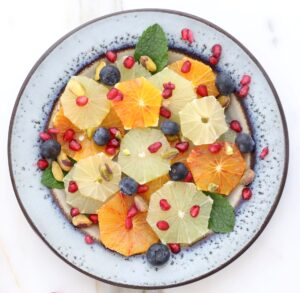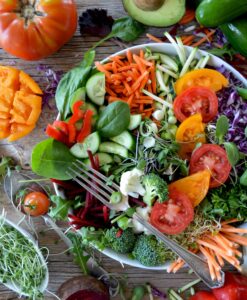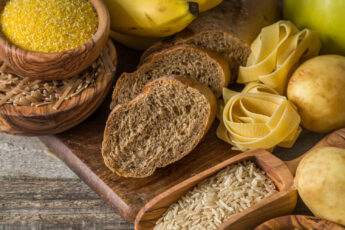Some interesting factoids in a survey from the Produce for Better Health Foundation (PBH), about people who reported eating lots of fruits and vegetables just released:

Photo by Sabine Thissen on Unsplash
• Twice as many fruit eaters report being happy, compared with people who do not eat fruit (68% vs 66%).
• The “dose response”: The more days of the week that fruits and vegetables were eaten, the higher the percentage of people who reported being happy in the 4 weeks prior to this survey.
• Those who said they don’t eat fruits or vegetables were much more likely to report being unhappy.
Fine Print: This was not a clinical study, it was a survey. These associations do not prove cause-and-effect, and clinical behavioral research is still needed to test these associations. So, it’s impossible to know for certain if people felt happier BECAUSE they ate more fruits and vegetables of if eating more was a RESULT of being happier first. NOTE: Some clinical research on the effects of fruit and vegetable consumption has been done, and the results show real promise. For us geeks, a pile of it is summarized here.
Taylor Wallace, PhD, the PBH Chief Food and Nutrition Scientist, acknowledges that conditions like depression and anxiety disorders are “serious disorders that can require help from doctors and therapists,” and advises a lifelong approach for the best benefit. “Whether you have a diagnosed mood disorder or just a case of the blahs, consistently eating at least five servings of fruits and vegetables a day may help. It’s the long-term pattern that counts.”
Fruits and vegetables may not be “magic pills” to happiness, but there are decades of evidence in favor of eating them. Aside from emotional well-being, eating more fruits and vegetables can help you:
• Better manage your weight, because they’re filling and low in calories.
• Reduce bad cholesterol levels
• Prevent constipation, because of their fiber content
• Reduce or prevent high blood pressure (remember: they’re an important part of the DASH Diet: Dietary Approaches to Stop Hypertension – easy summary here)
• Correct your dietary gaps: only about 1 in 50 people gets the amount of fruits and vegetables recommended.
What’s very clear: NOT eating more fruits and vegetables puts you at higher risk of chronic health problems, while eating more of them MAY help improve your mood and outlook on life.
Where Stops Happen
Among survey responders who seldom ate fruits and vegetables, they mentioned these barriers to doing so:
• Lack of preparation skills
• Finding options that appeal to the whole family
• Physical limitations
• Affordability
Even more interesting: these barriers were also cited by people who DO eat fruits and vegetables 6 or 7 days a week, suggesting that they’d found ways to overcome the barriers and “make it work.”
A lesson to us all: work with whatever tools we have to get where we want to be.
7 Hacks For Hiking EVERYONE’S Fruit & Veggie Count

Photo by Nadine Primeau on Unsplash
• Best fruits and vegetables? The ones you’ll actually eat! If you hate kale, skip it! Prefer more fruit than veggies? Fine. Start there and try something new each week. There are so many varieties you’ll surprise yourself.
• Everything counts: fresh is nice, but canned, frozen, dried are all good too. With canned fruit, aim for those packed in juice or water.
• Juice counts, too – just make sure you keep it to 8-oz. per day, then go for whole forms. Read here why commercially processed orange juice may be even better than fresh-squeezed.
• Limited budget? You have lots of company, but buy what you can afford.
• Organic too expensive? No worries! I seldom buy organic unless it’s affordable. Conventionally grown produce is just as nutritious – and there’s a whole lot of science that says so.
• Make it automatic: Include a fruit or vegetable (or both!) part of every meal. Start easy, with breakfast, and gradually expand.
• Shift the home food environment to keep have fruits and veggies around, available, and ready! Pull empty-calorie snacks from the counter and the fridge and let them run out. Then, keep those purchases to a minimum – you’ll save money and have more to spend in the produce aisle.
**PRO-TIP for “resistance management“: Yes, you may get pushback from kids (spouses?) on this. They’ve been used to a certain pattern, so enlist their input on their favorite fruits and vegetables. Explain that snacks they’ve been used to will be around, but not as many of them and not as often. Instead, “go-to” snacks will be their favorite fruits and vegetables, and foods like nuts, low-fat Greek yogurt, etc. The protests will end when you set your “produce policy.” Give kids the opportunity to: 1) learn to make gradual changes and 2) learn to like them.
Frequency matters: The more often people ate fruits and veggies, the more they ate of them each time.
Personal story: Here’s a “thank you” to my mother: Growing up, she made sure there were always bowls of fruit on the kitchen counter and in the fridge. We had cookies or sweets occasionally, but if we ate them too quickly, they were not replaced quickly. Salads? A dinner menu standard. We had a food budget, and empty-calorie stuff wasn’t on it. Result: Give me a bowl of berries over a cookie any day.
Featured photo by Luisa Brimble on Unsplash







